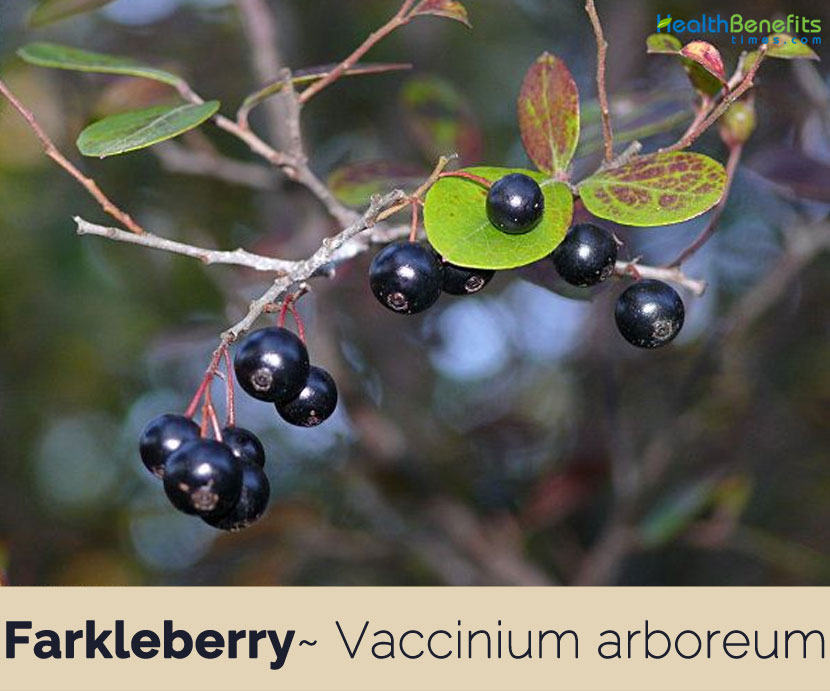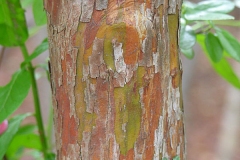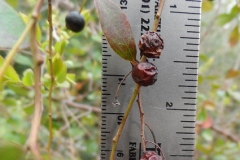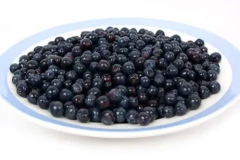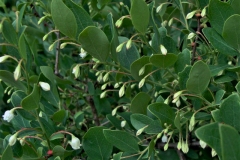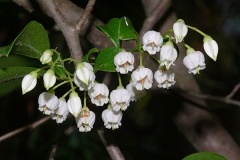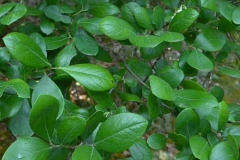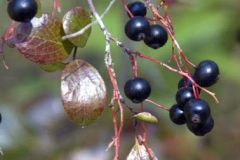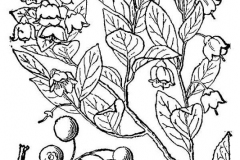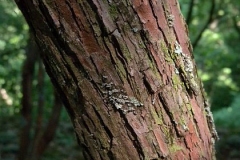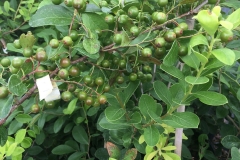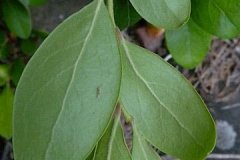| Farkleberry Quick Facts | |
|---|---|
| Name: | Farkleberry |
| Scientific Name: | Vaccinium arboreum |
| Origin | Central Florida westward to central Oklahoma, southeastern Missouri, southeastern Kansas, and the Edwards Plateau of Texas |
| Colors | Initially green and slowly turn darker until they are a deep blue to black |
| Shapes | Black, lustrous, globose berry 0.2 to 0.4 inch (5-9 mm) in diameter. |
| Flesh colors | Dry, hard, and mealy |
| Taste | Sweet to sour |
| Health benefits | Beneficial for diarrhea, dysentery, sore throats, chronic ophthalmia, leucorrhoea and many more |
| Name | Farkleberry |
|---|---|
| Scientific Name | Vaccinium arboreum |
| Native | Central Florida westward to central Oklahoma, southeastern Missouri, southeastern Kansas, and the Edwards Plateau of Texas. It extends northward to southern Illinois, southern Indiana, and Virginia |
| Common Names | Farkleberry, Sparkleberry, Winter huckleberry, Tree sparkleberry, Tree-huckleberry, tree whortleberry, winter whortleberry, Missouri farkleberry |
| Name in Other Languages | English: Farkleberry, Sparkleberry, Winter huckleberry, Tree sparkleberry, Tree-huckleberry, tree whortleberry, winter whortleberry, Missouri farkleberry, French: Airelle en arbre, myrtillier en arbre German: Schweinsbeere Italian: Mirtillo arboreo |
| Plant Growth Habit | Large, stiff-branched, evergreen or persistent-leaved, upright shrub or small tree |
| Growing Climates | Grows on sand dunes, hammocks, granitic outcrops, dry sterile hillsides, rocky woods, abandoned fields, meadows, wet bottomlands, along creek banks, coastal plain, in Piedmont, Moist sandy soils by ponds and streams, stream banks, bluffs, rocky ledges, rocky canyons, rocky ravines, rocky bluffs, sandstone glades, barren upland savannas, sand dunes, sandy savannas, pinelands, thickets, clearings, fields, coastal scrub forests, wooded streams |
| Soil | Found growing on moist, acid, sandy, well-drained soils |
| Plant Size | 3–5 m (7.5-12.5 feet) rarely 9 m) (22.5 feet) tall, with a diameter at breast height of up to 35 cm (14 inches) |
| Bark | Outer bark is gray to grayish-brown, thin, and smooth, with narrow ridges |
| Twigs | Slender, rigid twigs are reddish-brown to reddish-green or gray, and glaucous, glabrous, or glandular-pubescent |
| Leaf | Simple, alternate leaves are coriaceous, glabrous, and lustrous above. The lower surface is glaucous, duller green, and often glandular-pubescent. Leaves are obovate to elliptic, approximately 1 to 3 inches (3-8 cm) in length with entire or obscurely denticulate margins |
| Flowering season | July to August |
| Flower | Showy, white to pinkish flowers of farkleberry grow in abundance. The perfect flowers are borne in leafy-bracted racemes or panicles that average 0.8 to 2.7 inches (2-7 cm) in length |
| Fruit Shape & Size | Black, lustrous, globose berry 0.2 to 0.4 inch (5-9 mm) in diameter. Berries are sweet but dry, hard, and mealy |
| Fruit Color | Initially green and slowly turn darker until they are a deep blue to black |
| Propagation | By seed, also propagated by softwood and hardwood cuttings |
| Seed | 8 to 10 stony, shiny, black to golden-brown seeds. The variously-shaped, deeply pitted seeds average 0.08 inch (2 mm) in length |
| Taste | Sweet to sour in taste |
| Season | September to October |
Plant Description
Farkleberry is a large, stiff-branched, evergreen or persistent-leaved, upright shrub or small tree that normally grows about 3–5 m (7.5-12.5 feet) tall, with a diameter at breast height of up to 35 cm (14 inches). However, on favorable sites, plants may grow to 33 feet (10 m) with a d.b.h. of up to 14 inches (35 cm). Record trees have been measured at 64 feet (19 m) in height with circumferences of up to 116 inches (45.9 cm). Farkleberry is the only member of the Vaccinium genus to reach tree size. The plant is found growing on sand dunes, hammocks, granitic outcrops, dry sterile hillsides, rocky woods, abandoned fields, meadows, wet bottomlands, along creek banks, coastal plain, in piedmont, moist sandy soils by ponds and streams, stream banks, bluffs, rocky ledges, rocky canyons, rocky ravines, rocky bluffs, sandstone glades, barren upland savannas, sand dunes, sandy savannas, pine lands, thickets, clearings, fields, coastal scrub forests and wooded streams. The plant prefers moist, acid, sandy and well-drained soils.
Trunk
The trunk bark is brown, gray, or red, or some combination these colors; it is thin and susceptible to shredding. Branches and older twigs are gray and relatively smooth, while young twigs are reddish brown. Branches and twigs of this shrub are often bent. Young shoots are light green to reddish green and usually pubescent, otherwise they are glabrous. The wood is brown to reddish-brown, fine-grained, tough and hard. Wood weighs an average of 48 pounds per cubic foot (112 kg/cu m). It was previously used to make various tool handles and craft items.
Leaves
Leaves are deciduous but can exhibit more evergreen characteristics in the warmer climates of its southern range. Leaves of farkleberry are variable in size, shape, and persistence. The simple, alternate leaves occur along the young twigs and shoots. These leaves are 1-3 inches in length and ½-1½ inches across, and somewhat leathery in texture. They are ovate, obovate, or broadly elliptic in shape, while their margins are smooth (entire) or minutely serrated. The leaf tips are either rounded or taper abruptly to blunt points, while the leaf bases are usually wedge-shaped. Leaf venation is pinnate; the secondary veins are widely separated and relatively sparse across the leaf surface. The upper leaf surface is medium green, glabrous, and somewhat shiny, while the lower leaf surface is pale green and glabrous to finely pubescent (fine hairs are most likely to occur along the central veins of the leaves). The leaves often become red or purplish red during the winter.
| Woody Plant Leaf Characteristics | Broad leaf Evergreen |
| Leaf Color | Green, Red/Burgundy |
| Leaf Feel | Glossy, Leathery |
| Leaf Value To Gardener | Showy |
| Deciduous Leaf Fall Color | Red/Burgundy |
| Leaf Type | Simple |
| Leaf Arrangement | Alternate |
| Leaf Shape | Elliptical |
| Leaf Margin | Entire |
| Hairs Present | Yes |
| Leaf Length | 1-3 inches |
| Leaf Width | 1-3 inches |
Flowers
The showy, white to pinkish flowers of farkleberry grow in abundance. The perfect flowers are borne in leafy-bracted racemes or panicles that average 0.8 to 2.7 inches (2-7 cm) in length. Inflorescences typically occur on second year growth. The central stalks of these racemes are light green and finely pubescent, while the pedicels are about ½ inches long, light green, and glabrous. Each flower is about ¼ inches long and similarly across, consisting of a short calyx with 5 broad teeth. Bell-shaped corolla is nearly globoid in shape, 10 inserted stamens, and a pistil with a single style. The calyx is light green and glabrous, while the corolla is usually white (less often pinkish white). The corolla also has 5 small lobes along its outer rim that are recurved. In addition to the flowers, the racemes have leafy to scale-like bracts that are less than 1 inch in length. The blooming period occurs from July to August for about 3 weeks.
| Flower Color | White |
| Flower Inflorescence | Raceme |
| Flower Value To Gardener: | Fragrant |
| Flower Bloom Time | Spring
Summer |
| Flower Shape | Bell |
| Flower Size | < 1 inch |
Fruits
Later, fertile flowers are replaced by lustrous, globoid berries about 0.2 to 0.4 inch (5-9 mm) in diameter at maturity during the late summer or fall. Fruits are initially green turning to black and shiny berries when ripe, often persisting into the winter. The interior of the berries is mealy and dry, varying in flavor from bitter to sweet. Each berry consists of 8- 10 seeds. The seeds are stony, shiny, and black to golden brown colored. The variously-shaped, deeply pitted seeds average 0.08 inch (2 mm) in length.
| Fruit Color
|
Black
Purple/Lavender |
| Fruit Value To Gardener
|
Showy |
| Display/Harvest Time | Fall |
| Fruit Type | Berry |
| Fruit Length | < 1 inch |
| Fruit Width | < 1 inch |
Traditional uses and benefits of Farkleberry
- Berries, root-bark and leaves are very astringent and have been used internally in the treatment of diarrhea, dysentery etc.
- The infusion is valuable in treating sore throats, chronic ophthalmia, leucorrhoea etc.
- Extracts obtained from roots were traditionally used to treat diarrhea.
- Extracts of the leaves have been used to treat sore throats and loose stools.
- Juice from berries has also been used to treat recurring cases of dysentery.
Other Facts
- Plant is said to be an excellent root stock for ‘Rabbiteye’ blueberries.
- Tannin is obtained from the bark and root.
- Wood is heavy, hard, very close grained and is used for making tool handles and other small articles.
- Farkleberry bark was formerly used in tanning leathers.
- Berries of farkleberry are inedible to humans.
- Flowers are a good source of nectar for foraging honey bees.
- Record trees have been measured at 64 feet (19 m) in height with circumferences of up to 116 inches (45.9 cm).
- The wood has been used for tobacco pipes, woodenware, and novelties.
Culinary Uses
- Fruit can be consumed raw or cooked, it is dry and slightly astringent but with a pleasant flavor.
- Historically the berries were used in pies and jellies.
References:
https://www.itis.gov/servlet/SingleRpt/SingleRpt?search_topic=TSN&search_value=23580#null
https://npgsweb.ars-grin.gov/gringlobal/taxonomydetail.aspx?id=40984
https://pfaf.org/user/Plant.aspx?LatinName=Vaccinium+arboreum
https://gd.eppo.int/taxon/VACAR
https://plants.usda.gov/core/profile?symbol=VAAR
https://www.fs.fed.us/database/feis/plants/shrub/vacarb/all.html
https://en.wikipedia.org/wiki/Vaccinium_arboreum
https://www.wildflower.org/plants/result.php?id_plant=vaar
https://edis.ifas.ufl.edu/fr320
http://www.theplantlist.org/tpl1.1/record/tro-12302743
https://www.augustaga.gov/1634/Sparkleberry
https://www.cabi.org/isc/datasheet/55997
https://davesgarden.com/guides/pf/go/31655/#b


